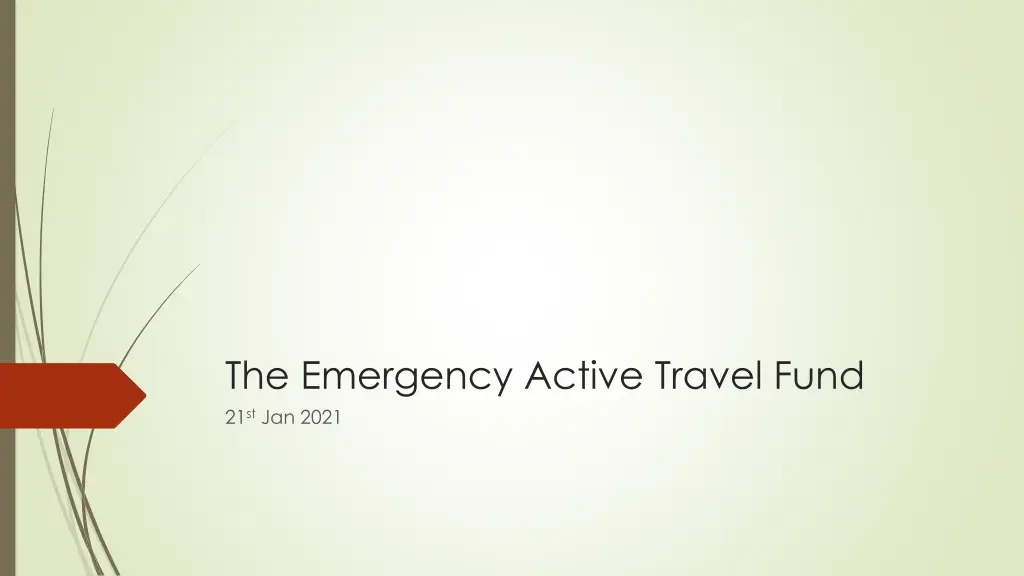
Emergency Active Travel Fund and the Need for Cycling Infrastructure
Learn about the Emergency Active Travel Fund established to address the reduced public transport capacity during the pandemic, leading to the promotion of cycling as a safe alternative. Explore how initiatives like protected cycling facilities and temporary cycle lanes are shaping active travel solutions for key workers and the community.
Download Presentation

Please find below an Image/Link to download the presentation.
The content on the website is provided AS IS for your information and personal use only. It may not be sold, licensed, or shared on other websites without obtaining consent from the author. If you encounter any issues during the download, it is possible that the publisher has removed the file from their server.
You are allowed to download the files provided on this website for personal or commercial use, subject to the condition that they are used lawfully. All files are the property of their respective owners.
The content on the website is provided AS IS for your information and personal use only. It may not be sold, licensed, or shared on other websites without obtaining consent from the author.
E N D
Presentation Transcript
The Emergency Active Travel Fund 21st Jan 2021
The Emergency Active Travel Fund (EATF) - Why was it needed Under CV19, Bus and Train Companies needed to maintain 2m between their Passengers. This meant that a Single Decker Bus, such as used on the Number 8 Service from Waterlooville to Portsmouth, via QA Hospital, had an approx 70% reduction in capacity Many Key Workers such as Nurses, Porters, Doctors,, Teachers etc still needed to travel to work, and many would normally have used Public Transport (PT). With this reduction in Capacity on PT, these users still needed to travel to work Many people use Public Transport for any numerous Reasons, including Protected Characteristics such as Age - too young to drive, disabilities Unable to drive, poverty can t afford to own and run a vehicle. Government advice to Avoid Public Transport if possible An instant alternative needed to be found that didn t cause other problems such as increased costs(e.g. taxis), parking, car led recovery
Enter: Cycling. Many people already own a Cycle. A Cycle journey is Door to Door, Cycling is CV19 safe - no sharing with others needed BUT most people won t cycle because they feel it unsafe To enable people to Cycle, it needed to be made to feel Safe Provide Protected Cycling Facilities, Separated from Motor Traffic
Nobody will travel on a Cycle far It ll take too long Arrive at St Marys Hospital at 08:30 AM within a 15 Minute journey time Bus: Pink Cycle (Leisurely): Blue Travel Time Map | Drive Time Radius & Other Modes
How to Make Space? Significantly less Motor Traffic on the Roads : Approx 90% of typical Vehicular Traffic in April 2020 - But some vehicular traffic travelling Significantly Faster than normal 65% of people across England support reallocating road space to cycling and walking in their local area. Nearly eight out of ten people (78%) support measures to reduce road traffic in their neighbourhood [1] Materially Re-allocate Space to Active Travel
What? Temporary cycle lane creates route to help key workers (leicester.gov.uk)
Funding Delivered in 2 Tranches, - 250M across England Tranche 1 Announced 9th MAY 2020 Portsmouth CC Indicatively Allocated 961,000 (May 29th) [1] Rapid Deployment Needed Deliver First, Reclaim Later Principle if possible. Bid s Needed to Justify Requests Tranche 2 Announced Nov 2020 (~2 months late) Portsmouth CC s Final Allocations: Tranche 1: 214,515 Tranche 2: 461,400 Active travel fund: final allocations - GOV.UK (www.gov.uk)
Whats Next? Utilise EATF Tranche 2 funding to deliver long term, Improved Active Travel Facilities to enable people to travel without being driven. Portsmouth s Already Congested More people Travelling by Car and less by Public Transport = More Congestion.
